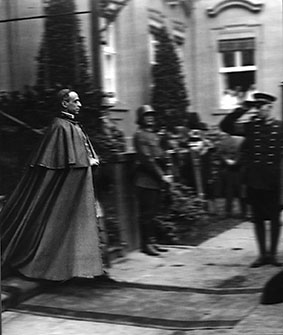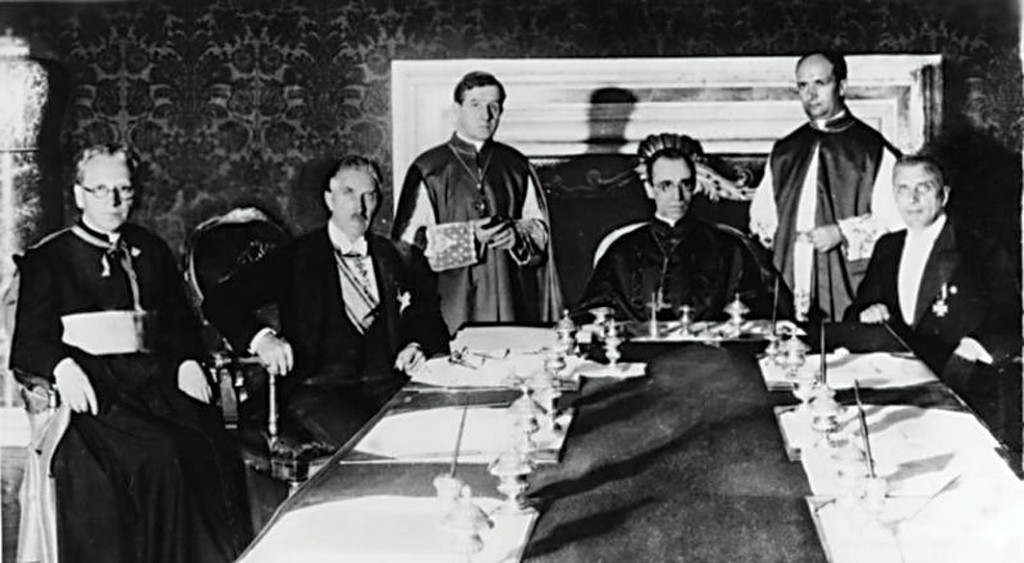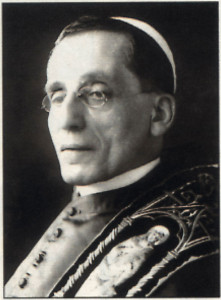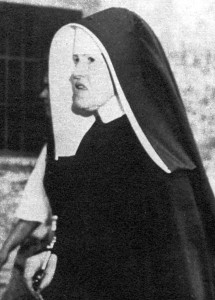At his death on October 9, 1958, Pope Pius XII enjoyed worldwide acclaim. Tributes to the deceased pontiff for his efforts to save Jews during Hitler’s Holocaust poured in from all sides. The New York Times took three days to print the tributes from New York City rabbis alone. The triumphal chariot got off to a good start. But Vengeance came limping after in 1963 in the form (of all things) of a stage play entitled The Deputy by the then 32-year-old German, Rolf Hochhuth.

Bishop Eugenio Pacelli in Germany. He was sent to Berlin as nuncio to the newly-created German republic in 1925
Born in 1931, Hochhuth had spent the last year of World War II as a junior member of the Hitler Youth. His play portrayed Pius XII as a cold-hearted cynic, more interested in the Vatican’s investment portfolio than in Hitler’s slaughter of European Jews, including those rounded up in Rome under the Pope’s own windows. The play’s message is well conveyed by its final line, in which the German ambassador to the Holy See, Ernst von Weisäcker, telegraphs his superiors in Berlin: “Since further action on the Jewish problem is probably not to be expected here in Rome, it may be assumed that this question, so troublesome to German-Vatican relations, has been disposed of.”
Seldom can a work of fiction have appeared at a time more favorable to its message. The 1960s saw publications proclaiming “the death of God” by liberal Christian theologians and at least one rabbi. It was also the age of the Youth Revolution, with the slogan, “Don’t trust anyone over 30.” A play which purported to unmask one of the world’s leading moral authorities was a godsend to the propagators of these new and exciting ideas.
The bureaucratically organized slaughter of Europe’s Jews was an event so horrible that many people found it difficult believe it was the work of a single individual, Adolf Hitler. Hochhuth helped them to come to terms with the inconceivable by assigning co-responsibility to the one man who (Hochhuth’s Black Legend alleged) could have stopped the machinery of death, had he wished to do so: the Pope of Rome. Millions who had never experienced the reign of terror imposed on Europe by the Nazis during World War II, with a totally controlled press and media, and people sent to concentration camps (which often meant death) simply for listening to news reports on British radio, welcomed Hochhuth’s indictment as an aid to understanding an event beyond the limits of what was previously considered possible.

The signing of the Reichskonkordat between the Holy See and Germany on July 20, 1933, in Rome. (From left to right: German prelate Ludwig Kaas, German Vice-Chancellor Franz von Papen, Secretary of Extraordinary Ecclesiastical Affairs Giuseppe Pizzardo, Cardinal Secretary of State Eugenio Pacelli, then-Monsignor (later Cardinal) Alfredo Ottaviani, and member of Reichsministerium des Inneren (Home Office) Rudolf Buttmann.
Appalled by a false version of events he had personally witnessed as a younger Vatican official, Pope Paul VI commissioned a team of four Jesuits to research the Vatican archives for documents showing the efforts of his World War II predecessor to save victims of Hitler’s terror: by public protests when the Pope thought these might have some effect and, more often, by frantic behind-the-scenes actions which depended for their effectiveness on public silence. Between 1965 and 1981 they published 12 thick volumes of documents. Few people bothered to read them. To this day the received opinion in most academic circles, and all but universally in the media, is that Pope Pius XII stands guilty as charged.

Pope Benedict XV (Pope during the First World War).
All the more credit, then, to Canadian historian Robert A. Ventresca for writing a biography of Pius XII based on genuine historical research. He quotes freely from the 12 volumes of Vatican documents. And he has been granted access also to the unpublished massive collection of personal testimonies from people who knew Pius XII. This is the so-called Positio, assembled in connection with the ongoing Roman process for the Pope’s beatification. The result is a solid account of the Pope’s life which corrects many still current misunderstandings and myths, though not all.
Eugenio Pacelli (the Pope’s original name) was sent to Germany as nuncio to the free state of Bavaria in 1917, charged by the reigning Pope Benedict XV with task of persuading the German government to make peace with the Western allies. Though unsuccessful in this, Pacelli remained in Munich until 1925, when he moved to Berlin as nuncio to the newly-created German republic.
His 12 years in Germany gave Pacelli a lifelong admiration for German discipline and order, a marked contrast to conditions in his own country. Ventresca quotes a remark by Pope Paul VI, who said that when Pacelli was recalled to Rome in December 1929 to become papal secretary of state and a cardinal, he “left his heart in Germany.” While there he had negotiated a favorable concordat between the Holy See and Bavaria in 1924, and a less favorable one with Prussia in 1929.
The whole notion of a concordat is alien to citizens of the United States, founded on the assertion in the American Declaration of Independence of “inalienable rights” granted to the citizens not by the state but by their “Creator.” The situation is different in Europe where, historically, the state has been considered omnicompetent, with citizens enjoying only those rights conceded to them by their rulers. A concordat, therefore, is an international treaty between a state and the Holy See guaranteeing liberty to the Church to manage its own affairs (appointment of bishops, for instance, and religious freedom in general) without state supervision or interference.

Mother Pasqualina.
Hitler’s appointment as Chancellor of Germany at the end of January 1933, and even more the passage in March 1933 of the Enabling Law giving Hitler dictatorial powers and suspending the constitutional guarantee of freedom of religion, made a concordat with the new government an urgent necessity for the Church.
In the event, however, the initiative for the treaty came not from the Vatican, but from Hitler, who authorized his Vice Chancellor, Franz von Papen, to travel to Rome in early April 1933 with the offer of a concordat. He received a cool reception from Secretary of State Pacelli, fully aware of how little faith could be placed in Adolf Hitler’s promises. The latter’s interest in a concordat arose from a single motive: the desire to remove Catholic clergy from party politics. Papen said from the start that this was a sine qua non for any agreement. Many Catholic priests were active members of the Center Party, founded under Bismarck to defend Church rights, and led in 1933 by Monsignor Ludwig Kaas. He and others held seats in the Reichstag, the German parliament.
Serious negotiations for an agreement came only at the end of June, when Hitler sent a new negotiator to Rome, undercutting von Papen with an offer of unexpectedly generous guarantees, especially for Catholic schools and youth organizations. Pacelli continued, however, to refuse agreement to the withdrawal of clergy from political activity until it became clear on July 1 that the Center Party was about to dissolve itself. It did so on July 5, 1933, the last German party to hold out against Hitler.
With only the Nazi Party remaining, the “depoliticization” of the clergy became, for the Holy See, not a concession, but a protection against attempts to enlist clergy for the only party remaining: Hitler’s. Thereafter things moved swiftly. The concordat was initialed in Rome on July 8, causing Hitler to end the harassment of Church personnel and organizations which he had mounted to put pressure on the Vatican. Ventresca’s account of this complex story overlooks documentary evidence now available which contradicts the charge of a secret “deal,” in which the concordat was Hitler’s quid pro quo for the Center Party’s assent to the Enabling Law. The Center Party acted independently of Rome; and Pacelli expressed regret for the party’s demise on July 5.
As secretary of state, Pacelli took the lead in drafting the encyclical Mit brennender Sorge, issued by Pope Pius XI on March 14, 1937. The document excoriated the Nazis for repeated violations of the concordat and contained what Ventresca calls “a clear rejection of the Nazi doctrine of racial purity [and] an unprecedented papal critique of Nazi divinization of race and state.”

Pope Pius XI
Following the death of Pius XI on February 10, 1939, Pacelli succeeded him as Pope Pius XII. His first encyclical, Summi pontificatus, issued on October 20, 1939, not two months after the outbreak of war, was a clear indictment, though guarded in language, of Nazi aggression, especially against “our dear Poland.” Heinrich Müller, head of the Gestapo in Berlin, wrote that the encyclical was “directed exclusively against Germany, both in ideology and in regard to the German-Polish dispute.” He was only half right. The Pope’s condemnation of “an ever increasing host of Christ’s enemies” included also the Soviet Union, which had joined Hitler in attacking and dismembering Poland.
Early in the war, the Polish Cardinal Augustus Hlond complained, from his safe exile in southern France, that the Pope was silent about the Nazis’ rape of his homeland. Similar complaints came from exiled Poles in England. In fact, Pius XII authorized Vatican radio to broadcast accounts in several languages, including German, of Nazi atrocities in Poland, starting in January 1940. The broadcasts stopped, however, when Catholics in Poland complained that German reprisals were intensifying their sufferings. In August 1942 an Italian priest, Msgr. Quirino Paganuzzi, was able to visit Cardinal Adam Stefan Sapieha in Cracow with a statement of support from Pius XII. Sapieha wept tears of joy at reading the message, then threw it into the fire, explaining that if he publicized it, “all our heads would fall.”
This incident exemplifies the Pope’s dilemma throughout the war. How often and how openly could he speak without worsening the sufferings of the victims? “The Pope was not silent throughout the war,” Ventresca writes. The Pope’s critics argue that his condemnations of the Nazis’ persecution of the Jews in his Christmas addresses of December 1941 and 1942 were too vague to be understood. This is nonsense. Commenting on the 1942 address, the New York Times called the Pope “a lonely voice crying out of the silence of a continent.” An official in Berlin called the Pope’s speech “one long attack on everything we stand for. He is clearly speaking on behalf of the Jews … and makes himself the mouthpiece of the Jewish war criminal.”
“It was Pius XII’s policy,” Ventresca writes, “to leave it to bishops and pastors who were working at the local level to decide whether or not to protest. . . . [His] aim was to avoid a greater evil — ad majora mala vitanda,” as the Pope wrote in a letter to Bishop von Preysing of Berlin on April 30, 1943. “This may even have saved lives,” Ventresca concedes, only to ask at once: “Was this enough?”
To that question, no certain answer is possible. All attempts, in any situation, to answer the question “what would have happened if…” are speculation, not history. What we do know is that the protest of the Dutch bishops against the persecution of Jews in July 1942 increased Jewish suffering. The Nazis immediately cancelled the protection previously accorded to Dutch Jews who had received Catholic baptism, and shipped them all to the Auschwitz death camp in Poland.
Ventresca cites what he calls a “purported” statement of Pius XII, “that if the protest of the Dutch bishops had led to the extermination of 20,000 Jews [a greatly inflated number, due to the lack of information under wartime conditions], I fear that my own statement . . . would result in the death of 200,000 Jews. I cannot, I should not accept such responsibility.”
Whereupon, as the Pope’s housekeeper, Mother Pascalina, testified after the war, the Pope went to the papal kitchen and burned the two-page protest he had drafted against the persecution of the Jews. Ventresca also reports that “around this time Pius XII personally authorized Mother Pascalina to use his private funds to help facilitate the migration of Jews from Italy to places like Canada and Brazil.”
We know also that Pius XII agonized over his dilemma. Ventresca writes about the Italian Army chaplain, Father Pirro Scavizzi, who sent the Pope reports about Nazi atrocities and met with him personally at least twice. After the war Scavizzi said that what he told Pius XII made him “weep like a child and pray like a saint.”
“Tell everyone,” Ventresca reports the Pope saying, “that the Pope agonizes for them and with them. Tell them that more than once I thought of striking Nazism with excommunication, or denouncing to the civilized world the bestiality of the extermination of the Jews… After many tears and much prayer, I decided that a protest from me would not have helped anyone, and would have provoked the most ferocious ire against the Jews, and multiplied acts of cruelty.” That was a prudential judgment. Who can say with certainty that it was wrong?
Ventresca is on more solid ground in asking why the Pope did not speak clearly about the Holocaust once the war was over and the fear of “making things worse” was removed. Jacques Maritain, the distinguished French intellectual who was that nation’s ambassador to the Holy See immediately after the war, implored Pius XII in July 1946 to condemn anti-Semitism publicly. Less than a month later, on August 3, 1946, the Pope, in a speech published on the front page of the Vatican newspaper L’Osservatore Romano, explicitly condemned “fanatical anti-Semitism” before an audience that needed to hear his words: the Judaeo-phobic Supreme Arab Committee on Palestine. Clear as this was, it fell short of the programmatic statement Maritain had requested.
Looking back, we can see that the concepts and language the Pope needed — starting with references to Jews as our elder brothers in faith — were not available during his lifetime. Brought forward during the Second Vatican Council, this new language aroused embittered opposition, which is still continued today by the Society of St. Pius X.
The Council’s decree Nostra aetate, promulgated by Pope Paul VI on October 28, 1965, broke new ground by saying that “the Jews should not be presented as rejected or accursed by God, as if this followed from the Holy Scriptures… The Church, mindful of the patrimony she shares with the Jews and moved not by political reasons but by the Gospel’s spiritual love, decries hatred, persecutions, displays of anti-Semitism, directed against Jews at any time and by anyone.”
One can be grateful to Ventresca for demolishing much of the Black Legend which indicts Pius XII as a cynical coward, indifferent to human suffering. The Legend’s complete refutation awaits the opening of the Vatican archives for the pontificate of Pius XII, now happily less than two years distant.
John Jay Hughes, a Church historian and priest in St. Louis, is author of the memoir, No Ordinary Fool: A Testimony to Grace.






Facebook Comments